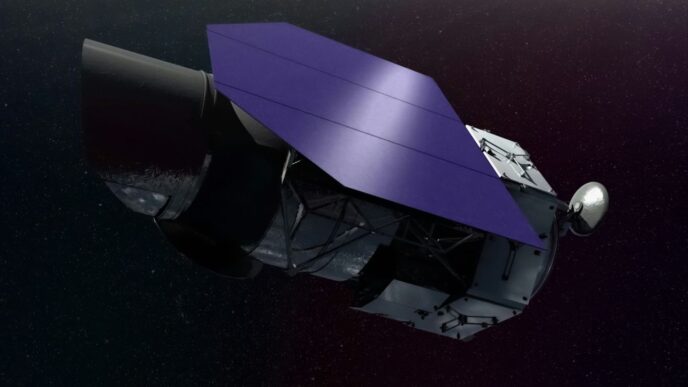Apex Satellites: Driving Innovation in Space Manufacturing
Building satellites used to be a really slow and expensive process. Think about it, each one was practically custom-built, taking years and costing a fortune. This was fine when only a few satellites were launched, but now? Things are changing fast. We’re seeing a huge push for large satellite constellations, and the old way just doesn’t cut it anymore. Apex Satellites is stepping in to change all that. They’re bringing new ideas to how we make satellites, focusing on speed, cost, and using better materials.
The Rise of Advanced Composite Materials
Forget the old, heavy metals. The satellite world is moving towards advanced composite materials. These aren’t your grandpa’s fiberglass; we’re talking about materials that are super strong but incredibly light. This is a big deal because launching anything into space costs a ton, so every pound saved matters. Plus, these new materials can handle the harsh conditions of space better, like extreme temperature swings, without breaking the bank. It’s like upgrading from a clunky old truck to a sleek, high-performance sports car – but for space.
High-Rate Production for Constellations
Launching one satellite is one thing, but launching hundreds or even thousands? That requires a whole different approach. Apex is looking at ways to make satellites much faster, almost like an assembly line. This isn’t about cutting corners; it’s about smart design and manufacturing processes that allow for mass production. Think about how cars are made today versus 50 years ago. That’s the kind of leap Apex is aiming for in the satellite industry. This speed is key for building out those big constellations needed for things like global internet or advanced Earth observation.
Reducing Costs and Accelerating Timelines
When you combine advanced materials with faster production methods, the costs naturally come down. This makes space more accessible. It means smaller companies, researchers, and even governments can afford to put their own satellites into orbit. What used to take years from design to launch can now potentially be done in a fraction of the time. This acceleration is vital for staying competitive and for responding quickly to new opportunities or challenges in space.
Apex’s Nova Platform: Meeting Evolving Mission Demands
So, Apex has this new thing called the Nova platform, and it’s pretty neat. It’s basically a satellite bus, which is like the body of a satellite, designed to carry all the important stuff. What’s cool about Nova is that it’s built for those big groups of satellites, you know, the ones they call constellations, especially those going into Low Earth Orbit (LEO). Think of it as a workhorse for missions that need to be up there reliably and in larger numbers.
Supporting Proliferated LEO Missions
LEO is getting pretty crowded, and a lot of government and commercial outfits want to put lots of satellites up there. Nova is made to handle that. It’s designed to fit within the launch envelope of rockets like the SpaceX Falcon 9, which is a big deal for getting things into orbit efficiently. They’re aiming to start delivering these by Q3 2025, which is pretty soon. This means they can support things like the Space Development Agency’s architecture and other classified programs that need a steady stream of satellites.
Designed for Power and Payload Capacity
When you’re sending up a constellation, you need satellites that can do a lot. Nova can carry payloads weighing between 200 to 500 kilograms. Plus, it can deliver over 2.5 kilowatts of electrical power. This is important because more power means the satellite can run more advanced instruments or communicate more effectively. They offer different configurations, too. There’s a base version that fits the standard rideshare, and a ‘heavy’ configuration for when you need to pack in more. This flexibility means customers can get a satellite that’s just right for their specific needs without overspending.
A New Standard for Production Reliability
One of the biggest headaches in space is making sure things work, and doing it consistently. Apex is trying to change that with a "productized" approach. Instead of building each satellite bus from scratch every time, they’re standardizing the design and manufacturing process. This is how they can build them faster and more reliably. It’s like an assembly line for satellites, which helps cut down on costs and speeds up how quickly you can get from design to launch. This focus on reliable production is key for those large constellations where losing even one satellite can be a problem.
Revolutionizing Satellite Design with Apex
You know, building satellites used to be this super slow, incredibly expensive process. Think custom-made everything, lots of hand labor, and materials that cost a fortune. It made sense for those giant, once-in-a-decade missions, but the space game has changed. Now we’ve got these huge constellations of smaller satellites popping up everywhere, and the old way just doesn’t cut it anymore. Apex is really shaking things up by rethinking how satellite buses are made.
Productized Approach to Bus Manufacturing
Instead of building each satellite bus from scratch every single time, Apex is treating them more like a product. They’ve developed platforms like their Nova bus, which is designed to handle a lot of different missions. This means they can build these buses in a more standardized way. It’s kind of like how car manufacturers build different models on the same basic chassis. This productized approach means they can make them faster and, importantly, cheaper. They’ve got different configurations available, too, so customers can pick what works best for their specific needs, whether it’s for a big constellation or a specialized government mission.
Enabling Government and Commercial Exploration
This shift to productized satellite buses is a big deal for everyone wanting to get into space. For government agencies, it means they can get the assets they need deployed much quicker, which is pretty important when you’re talking about defense or monitoring things from orbit. For commercial companies, especially those launching those massive satellite constellations, it lowers the barrier to entry. It makes space more accessible for exploration and new business ideas. Instead of spending years and millions on a single bus, they can now get reliable platforms that are ready to go.
Standardization for Rapid Delivery
What Apex is doing with standardization is pretty neat. They’re making satellite buses that are designed for high-volume production. This means they can churn them out much faster than traditional methods. Think about it: if you need to launch hundreds of satellites, you can’t wait years for each one. Apex’s approach allows for rapid delivery because the design and manufacturing processes are already figured out and optimized. They can even build panels and components ahead of time, keeping them in inventory, and then assemble them quickly once a specific order comes in. This cuts down the time from when a customer decides they need a satellite to when it’s actually ready to launch from years to mere weeks.
The Future of Spacecraft Production
Addressing the Needs of Large Constellations
Building hundreds, or even thousands, of satellites for big constellations is a whole new ballgame. It’s not just about making one or two fancy spacecraft anymore; it’s about mass production, but for space. This means we need factories that can churn out satellites reliably and quickly. Think assembly lines, but for orbit. The old way of building satellites one by one, taking years for each, just won’t cut it. We’re talking about needing to get these things out the door much faster and cheaper to make these massive projects actually work.
The Role of Domestic Material Supply
It’s becoming pretty clear that relying too much on materials from other countries can be a problem. For space stuff, having a solid, domestic supply chain for all the bits and pieces is becoming super important. This isn’t just about national pride; it’s about making sure we can actually build what we need, when we need it, without getting held up by international issues. Having our own sources for things like advanced composites or specialized electronics means more control and less risk. It helps keep production humming along smoothly.
Streamlining Qualification for Commercial Success
Getting new materials and designs approved for space used to take ages. We’re talking like, 8 to 10 years sometimes. That’s way too long, especially for commercial companies trying to launch big satellite groups. The good news is, things are changing. New manufacturing methods and materials are cutting down that qualification time dramatically, sometimes to just a year. This speed is a game-changer. It means companies can get their new ideas into orbit faster, test them out, and start making money or doing their mission sooner. It’s all about making space more accessible and business-friendly.
Apex’s Contribution to Space Domain Awareness

Space is getting pretty crowded, and honestly, it’s not just about more satellites for communication or weather anymore. We’re seeing a real shift towards space being a place where different nations and companies have interests, and sometimes, those interests clash. Keeping track of everything up there – what’s moving, who’s moving it, and what they might be up to – that’s what we call Space Domain Awareness (SDA). It’s like having a really, really good security camera system for the entire planet, but for orbit.
Supporting Critical Defense Missions
Apex is stepping up to help out with defense needs in space. Think about it: if you’re trying to keep track of potential threats or just understand what’s happening in orbit, you need reliable ways to see and know. Our Nova platform, for example, is built to be flexible. It can carry different kinds of sensors and equipment that help gather information. This ability to quickly put advanced sensing capabilities into orbit is a big deal for defense. It means military planners can get a clearer picture of the space environment, which is pretty important when you’re talking about national security.
Accelerating the Deployment of Orbital Assets
One of the biggest challenges in SDA is speed. Threats can emerge quickly, and you need to be able to respond. Apex’s focus on making satellites in a more standardized, productized way really helps here. Instead of building each satellite from scratch, which takes ages, we’re making them more like interchangeable parts. This means we can build and launch satellites that are specifically designed for SDA missions much faster than before. We’re talking about getting new capabilities into orbit in months, not years. This rapid deployment is key to staying ahead in a fast-changing environment.
Competing in a Congested Space Domain
Let’s face it, space is becoming a busy place. There are more satellites from more countries and companies than ever before. This makes it harder to track everything and increases the chances of accidents or even intentional interference. Apex’s approach helps level the playing field. By making satellites more affordable and quicker to produce, we’re enabling more players – including government agencies and commercial partners – to put their own assets into orbit. This increased presence and capability helps everyone get a better handle on what’s going on, making the whole space domain more transparent and manageable for those who need to operate there safely and securely.
Advanced Materials for Next-Generation Satellites
Building satellites used to be a really slow and expensive process. Think about it, for years, companies relied on heavy, pricey materials and manufacturing methods that took ages, like hand-laying composites. This was fine when you were building one or two giant, multi-million dollar satellites. But now? The game has changed. We’re talking about huge constellations, hundreds or even thousands of smaller satellites, all needing to get into orbit quickly and without breaking the bank.
Achieving Thermal Stability at Lower Costs
One of the biggest headaches in satellite design is thermal expansion. When a satellite heats up or cools down in space, its parts can expand or contract. This might not sound like a big deal, but for things like high-resolution cameras, even tiny shifts can mess up the image quality. Traditionally, you’d use super expensive materials to keep this expansion in check. Apex is changing that. They’re using new composite materials, like those made with HM63 fiber, that offer amazing thermal stability without the crazy price tag. This means you can get that precision needed for sensitive instruments, but at a much more reasonable cost. It’s like getting the performance of a luxury car without paying for the luxury.
Manufacturability for High-Volume Production
Making lots of satellites means you need to make parts fast. The old ways just don’t cut it anymore. Apex is focusing on materials and processes that are easy to work with and can be produced in large quantities. Instead of using many layers of material, their approach often uses fewer, but more effective, layers. This simplifies the manufacturing steps. For example, they can create structural panels using just one layer of a special composite fabric, where older designs might have used eight. This isn’t just about saving time; it means less material waste and fewer labor hours. Think about it: if you can make a part in minutes instead of hours, and use half the material, the cost savings add up fast.
Enabling Faster Turnaround from Design to Orbit
This focus on advanced materials and simpler manufacturing has a huge impact on how quickly satellites can go from a drawing board to being in space. With traditional methods, qualifying new materials could take years. For companies building constellations, that’s way too long. Apex’s approach allows for a much quicker path to getting materials approved and ready for flight. It’s so streamlined that some companies can now produce common structural parts, like panels, and keep them in inventory. Then, when a specific satellite design is finalized, they can just grab a panel, trim it, and assemble it. This drastically cuts down the time from when a design is finished to when the satellite is actually ready to launch – we’re talking weeks instead of years. This speed is a game-changer for staying competitive in the fast-moving space industry.
Looking Ahead
So, what does all this mean for the future? Apex isn’t just building satellites; they’re changing how we build them. By focusing on advanced manufacturing and using new materials, they’re making space more accessible and affordable. This shift is huge, especially with more companies and governments wanting to put things in orbit. It means faster production, lower costs, and better performance, which is exactly what we need as more satellites get launched every year. Apex’s approach really seems to be setting a new standard for getting things done in space, making it easier for everyone to explore and use the final frontier.














